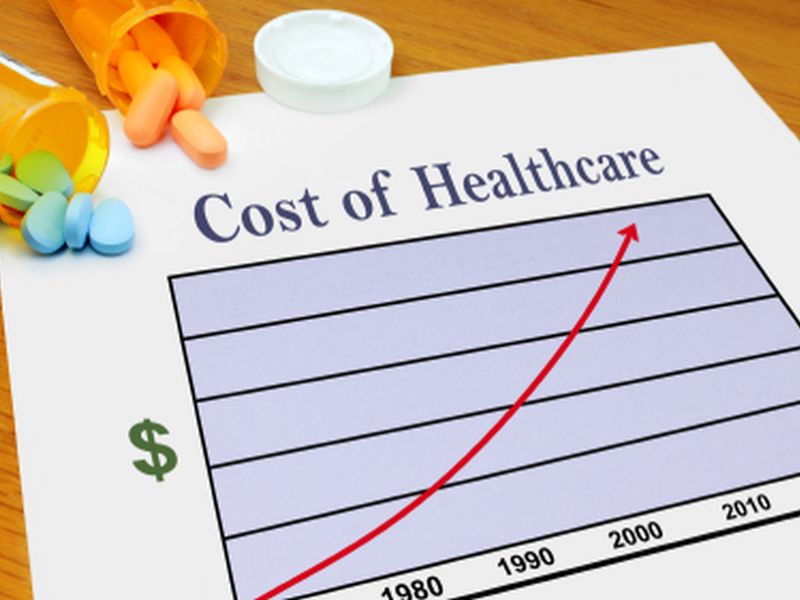Diabetes Takes Largest Chunk Out of U.S. Well being Care Spending
 By Dennis Thompson
By Dennis ThompsonHealthDay Reporter
WEDNESDAY, Dec. 28, 2016 (HealthDay Information) -- Diabetes leads a listing of simply 20 illnesses and circumstances that account for greater than half of all spending on well being care in the USA, in response to a brand new complete monetary evaluation.
U.S. spending on diabetes prognosis and remedy totaled $101 billion in 2013, and has grown 36 instances sooner than spending on coronary heart illness, the nation's No. 1 reason behind dying, researchers reported.
"After adjusting for inflation, we see that yearly the U.S. is spending 6 p.c greater than we spent the 12 months earlier than on diabetes," mentioned lead researcher Joseph Dieleman, assistant professor on the College of Washington Institute for Well being Metrics and Analysis.
"That is actually a exceptional development charge, notably sooner than the economic system is rising or well being care spending as a complete," he mentioned.
The annual charge of development in well being care spending between 1996 and 2013 has been three.5 p.c on common, Dieleman famous.
"Spending on diabetes grew twice as quick as all circumstances mixed" throughout that 18-year interval, he mentioned.
The research findings had been printed within the Dec. 27 situation of the Journal of the American Medical Affiliation.
People spent $2.1 trillion in 2013 on prognosis and remedy of well being issues, which quantities to greater than 17 p.c of the entire U.S. economic system, the researchers concluded from their evaluation of federal knowledge.
"That may be a staggering, nearly unimaginable quantity," Dr. Ezekiel Emanuel wrote in an editorial accompanying the brand new research. Emanuel is chair of medical ethics and well being coverage on the College of Pennsylvania.
"Certainly, this degree of spending makes the U.S. well being care system the fifth largest economic system on the planet, behind solely the U.S., Chinese language, Japanese and German nationwide economies," Emanuel identified.
Dieleman and his colleagues broke down the $2.1 trillion spent in 2013 throughout 155 totally different well being circumstances, to see which illnesses had been drawing in essentially the most .
The highest 10 most expensive well being bills in 2013, in response to the evaluation, had been:
- Diabetes -- $101.four billion.
- Ischemic coronary heart illness -- $88.1 billion.
- Low again and neck ache -- $87.6 billion.
- Hypertension -- $83.9 billion.
- Accidents from falls -- $76.three billion.
- Melancholy -- $71.1 billion.
- Dental care -- $66.four billion.
- Imaginative and prescient and listening to issues -- $59 billion.
- Pores and skin-related issues -- $55.7 billion.
- Being pregnant and postpartum care -- $55.6 billion.
"There are issues on that record that, once we consider well being care, they don't seem to be essentially the issues the common American would consider," Dieleman mentioned.
The primary 5 circumstances alone comprised 18 p.c of all private well being care spending and totaled $437 billion in 2013, the researchers famous.
Most cancers didn't make the record as a result of the researchers cut up the class into all several types of cancers, equivalent to breast most cancers and colon most cancers, Dieleman mentioned. All mixed, most cancers care price about $115 billion, the research discovered.
Nonetheless, Dieleman added that this research solely checked out whole spent on well being care, and never whether or not the had been spent properly. A follow-up report popping out in a number of months will join the cash to threat elements that trigger sickness.
"I consider this research as offering a panorama," he mentioned. "It tells you the place to start out digging deeper. For instance, it tells you we're spending notably extra on diabetes, and now we will take into consideration why that's."
Of the cash spent on diabetes care in 2013, greater than 57 p.c went to drugs and 23.5 p.c went to outpatient care, the research authors reported.
"We all know in diabetes a lot of the development was in prescription drugs," Dieleman mentioned.
However that does not essentially imply cash for drugs is ill-spent, he added.
"I believe persons are fast to level at pharma, but when drugs are stopping journeys to the clinic, that is not essentially a nasty factor," Dieleman mentioned. "Spending on remedy of excessive ldl cholesterol is sort of completely pharma, and that is in all probability factor."
Then again, billions are being spent on low again and neck ache, and 70 p.c of that spending is for working-age folks youthful than 65, Dieleman mentioned.
"After I discuss with medical docs about this, there's some cynicism concerning the effectiveness of the spending on low again and neck ache," he mentioned. "Low again and neck ache is definitely a kind of locations the place we're spending loads, and it encourages us to look nearer and consider what we're getting out of that spending."
Emanuel agreed in his editorial.
"Charges of pain-associated well being issues are literally growing, moderately than reducing, and few folks would charge the U.S. efficiency on these circumstances as exemplary," he wrote.
"Sufferers who need ache aid typically endure surgical procedure, even when relaxation, bodily remedy and nonsurgical interventions can be equally efficient," Emanuel mentioned.

Copyright © 2016 HealthDay. All rights reserved.
SOURCES: Joseph Dieleman, Ph.D., assistant professor, Institute for Well being Metrics and Analysis, College of Washington, Seattle; Dec. 27, 2016, Journal of the American Medical Affiliation
No comments:
Post a Comment